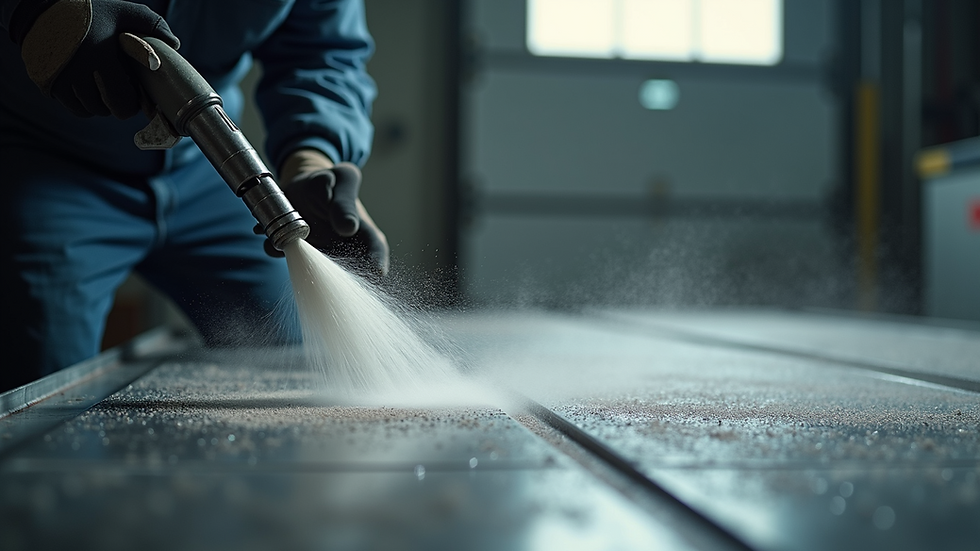Effective Sand Blasting Techniques for Metal Surfaces
- Mound House Powder Coating

- Nov 2
- 4 min read
When it comes to preparing metal surfaces for finishing, sand blasting stands out as a powerful and versatile method. Over the years, I have seen how the right sand blasting techniques can transform rough, corroded, or painted metal into a clean, smooth canvas ready for coating or painting. Whether you are working on industrial equipment, automotive parts, or architectural metalwork, mastering these techniques ensures durability and aesthetic appeal.
Sand blasting is not just about blasting sand at a surface. It’s a precise process that requires understanding the type of abrasive, pressure settings, and surface conditions. In this post, I will walk you through the most effective sand blasting techniques, share practical tips, and highlight alternatives that might suit your budget or project needs.
Understanding Sand Blasting Techniques for Metal Surfaces
Sand blasting, also known as abrasive blasting, involves propelling abrasive material at high velocity to clean or etch a metal surface. The goal is to remove rust, old paint, scale, or other contaminants while creating a profile that improves coating adhesion.
Here are some key techniques I recommend:
Pressure Blasting: Using compressed air to propel abrasive media. This is the most common method and works well for most metals.
Wet Blasting: Mixing water with abrasive media reduces dust and heat, making it ideal for delicate surfaces or indoor use.
Suction Blasting: Abrasive is sucked into the blast gun and propelled. It’s less aggressive and suitable for light cleaning.
Wheel Blasting: Uses a spinning wheel to throw abrasive at the surface. This is efficient for large, flat metal surfaces.
Choosing the right abrasive is just as important. Common abrasives include:
Silica Sand: Traditional but less used now due to health concerns.
Aluminum Oxide: Durable and reusable, great for heavy-duty cleaning.
Glass Beads: Provide a smooth finish, often used for polishing.
Steel Grit: Aggressive and fast, perfect for thick rust or scale.
Adjusting the pressure and distance from the surface controls the aggressiveness of the blast. For example, a higher pressure and closer distance remove tough rust but risk damaging thin metal. Conversely, lower pressure and greater distance are gentler but less effective on heavy contaminants.

Practical Tips to Maximize Sand Blasting Efficiency
To get the best results, I always emphasize preparation and technique. Here are some actionable recommendations:
Clean the Surface First: Remove loose dirt, grease, or oil before blasting. This prevents contamination and improves abrasive efficiency.
Select the Right Abrasive: Match the abrasive to the metal type and condition. For example, use glass beads for aluminum to avoid pitting.
Control the Environment: Sand blasting creates dust and debris. Use containment or do it outdoors with proper ventilation.
Test on a Small Area: Before full-scale blasting, test settings on a small section to avoid damage.
Maintain Equipment: Regularly check hoses, nozzles, and compressors to ensure consistent pressure and flow.
Wear Protective Gear: Safety goggles, respirators, and gloves are essential to protect against abrasive particles.
By following these tips, you can achieve a clean, uniform surface that enhances coating adhesion and extends the life of your metal parts.
What is a Cheap Alternative to Sandblasting?
Not every project requires the full power of sand blasting, especially if budget constraints or environmental concerns come into play. Here are some cost-effective alternatives I often recommend:
Wire Brushing: Manual or powered wire brushes can remove rust and paint on small areas. It’s labor-intensive but inexpensive.
Chemical Stripping: Using paint removers or rust converters can prepare metal surfaces without abrasive blasting. However, it requires careful handling and disposal.
Soda Blasting: Uses baking soda as an abrasive. It’s gentler and less harmful to the environment but may not be as effective on heavy rust.
Grinding and Sanding: Power tools with abrasive discs can clean metal surfaces but may leave uneven profiles.
Each alternative has pros and cons. For example, wire brushing is cheap but slow, while chemical stripping avoids dust but involves hazardous materials. Consider the metal type, surface condition, and final finish requirements before choosing.
How to Find Reliable Sand Blasting Services Near You
Sometimes, the best option is to hire professionals who specialize in sand blasting. They have the right equipment, expertise, and safety measures to handle your project efficiently. When searching for "sand blasting near me," look for providers with:
Proven experience in metal finishing
Use of modern, environmentally friendly abrasives
Ability to handle various metal types and sizes
Positive customer reviews and project portfolios
Compliance with safety and environmental regulations
For those in Northern Nevada or nearby regions, I recommend checking out Mound House Powder Coating. With over 30 years of experience, they offer expert sand blasting and specialized finishes like CERAKOTE, ensuring your metal surfaces are both durable and visually appealing.

Enhancing Metal Durability with Post-Blasting Finishes
Sand blasting is just the first step in achieving a long-lasting metal finish. After blasting, the surface is primed for coatings that protect against corrosion and wear. Here are some finishing options I suggest:
Powder Coating: Provides a thick, durable layer that resists chipping and fading. Ideal for outdoor and industrial applications.
CERAKOTE Ceramic Coating: A high-performance finish that offers excellent chemical and abrasion resistance. Perfect for firearms, automotive parts, and machinery.
Epoxy Primers: Seal the blasted surface and improve adhesion for subsequent paint layers.
Galvanizing: Applying a zinc coating to prevent rust, often used for structural steel.
Proper surface preparation through sand blasting ensures these finishes bond well and perform optimally. Skipping or rushing the blasting step can lead to premature coating failure and costly repairs.
Mastering effective sand blasting techniques is essential for anyone working with metal surfaces. Whether you choose to do it yourself or hire experts, understanding the process helps you make informed decisions that enhance durability and appearance. If you want to explore professional options, consider searching for sand blasting near me to find trusted providers who can deliver expert results tailored to your needs.




Comments